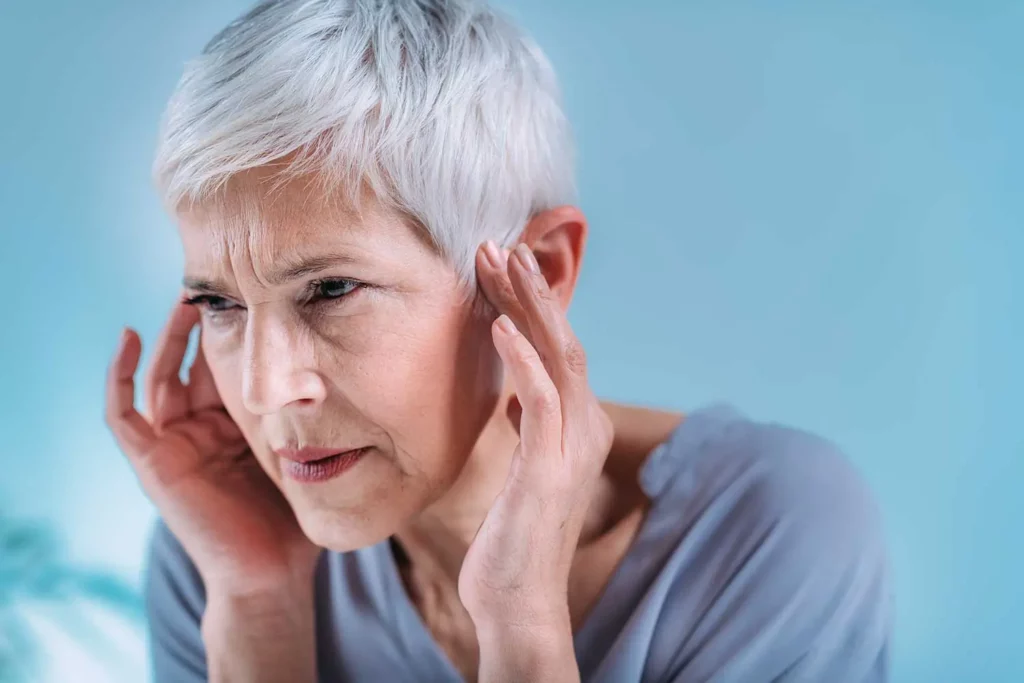Mr Mouli Doddi
Tinnitus is the term used to describe the perception of noise in the ears. Most people describe it as a ringing noise, but it can be a hissing, humming, buzzing, or a clicking sound.
10-15% of adults are believed to have tinnitus. The prevalence of tinnitus is higher in males, people with diabetes, hypertension, dyslipidaemia, anxiety, depression, and exposure to loud noises.
Tinnitus can be primary (Idiopathic) or secondary. In primary tinnitus there is no identifiable cause other than hearing loss, while secondary tinnitus is associated with an underlying cause.
Tinnitus can also be subjective or objective. Subjective tinnitus is when the noises are only perceived by the patient. It is the most common form of tinnitus and makes up 99% of the cases. Objective tinnitus is when the noises can also be perceived by others nearby. It is extremely rare and forms less than 1% of the cases.

What causes tinnitus?
Tinnitus is not a disease. It is a symptom occurring due to a cause. In majority of the patients, the tinnitus is Primary (Idiopathic) and Subjective, which means that the tinnitus does not have an identifiable cause and is audible only to the patient.
| Ear conditions | Outer ear | Wax, ear infections, |
| Middle ear | Otosclerosis (abnormal bone growth in the middle ear causing hearing loss), Eustachian tube dysfunction (tube that equalises air pressure in the middle ear) | |
| Inner ear | Sensory neural hearing loss (Hearing loss caused by damage to the inner ear and the nerve of hearing. It is commonly caused by ageing and noise) Meniere’s disease (a condition of inner ear that causes dizziness, hearing loss and tinnitus), Acoustic neuroma (rare, benign brain tumour). | |
| Medications | Aspirin | High doses of greater than 2.7grams a day |
| Nonsteroidal anti-inflammatory drugs | Ibuprofen, diclofenac, naproxen etc | |
| Antibiotics | aminoglicosides (Gentamycin), Erythromycin, doxycycline, vancomycin, Imepenam, amphotericin, ganciclovir | |
| Other medications | Chemotherapy agents, loop diuretics (Furosemide), antiarrhythmics, anticonvulsants, antihypertensives, antiulcer drugs, hormones, psychotropic drugs, atorvastatin, chloroquine, Quinine. | |
| Somatosensory | Temporomandibular joint dysfunction, Whiplash | |
| Neurological | Idiopathic intracranial hypertension, spontaneous Intracranial hypotension, vestibular migraine, multiple sclerosis, Type 1 Chiari malformation. |
Objective tinnitus is rare and is usually caused by muscle contractions and blood vessel abnormalities. Common causes are:
| Vascular | arterial bruit, venous hum, arteriovenous malformation, vascular tumours, carotid atherosclerosis |
| Neurological | Palatal myoclonus, idiopathic stapedial or tensor tympani muscle spasm |
I can hear a whooshing sound, like the sound of my pulse. Is this tinnitus?
Yes. It is called pulsatile tinnitus. If it occurs at the same time as the heartbeat, it is called Synchronous pulsatile tinnitus and if it does not occur at the same time as the heart beat it is called asynchronous pulsatile tinnitus. It is caused by several different conditions such as irregular blood vessels, high blood pressure, raised intracranial pressure, anaemia and atherosclerosis.

Common causes of pulsatile tinnitus are:
| Synchronous | Vascular | Anaemia, Hypertension. Venous hums caused by turbulent blood flow through the jugular bulb, dehiscent bone over sigmoid sinus or sigmoid sinus diverticulum. Carotid bruit due to carotid artery stenosis, carotid atherosclerosis, arterio-venous malformations. |
| Nonvascular | paragangliomas, intracranial hypertension. | |
| Non-synchronous | palatal myoclonus |
Can Temporomandibular joint pain and neck pain cause tinnitus?
Yes. It is called Somato-sensory tinnitus (ST). Musculoskeletal symptoms like neck tenderness, tenderness of mastication muscles, temporomandibular joint pain or crepitus are all suggestive of somatosensory tinnitus.
What is somato-sensory tinnitus?
Somatosensory system is a part of the sensory network of nerves. British Tinnitus Association states that a change in somatosensory information from the cervical spine or jaw area can result in tinnitus. Studies have shown a connection between the somatosensory system of neck and jaw and the central auditory system.
The prevalence of somato-sensory tinnitus is believed to be 12-16%.
How can somato-sensory tinnitus be treated?
An expert committee constituted by the British Tinnitus Association recommended that physiotherapy for the neck and orofacial physiotherapy/splint for temporomandibular joint can help the tinnitus.
Can loud noise cause tinnitus?
According to the American Tinnitus Association (ATA), noise exposure is the largest attributed cause of tinnitus. Prolonged noise exposure from occupational or recreational activities can result in tinnitus
Is tinnitus related to depression and anxiety?
Studies have reported that 50% of people with tinnitus have depression. The severity of depression and anxiety has been related to the severity of tinnitus, though the precise reason is poorly understood.
Is it common for tinnitus to affect sleep?
More than half the patients with tinnitus report sleep deprivation. The World Health Organization categorized the functions impaired by tinnitus into 4 groups: 1) thoughts and emotions, 2) hearing, 3) sleep, and 4) concentration.
Does increased cellular phone usage cause tinnitus?
Studies do not show a consistent association between cellular phone usage and tinnitus.
Will tinnitus improve spontaneously?
Various research studies show that in 20% of the people, tinnitus will improve spontaneously. If the tinnitus is present for more than 6 months, it is less likely to resolve spontaneously.
Are any tests needed for tinnitus?
All patients with tinnitus will need a comprehensive hearing test. It is called a pure tone audiogram with masking, and tympanogram. Based on the associated symptoms and examination, especially if the tinnitus is unilateral an MRI scan of the head (Internal acoustic meatus and brain) or a CT scan the temporal bone and head may be needed.
Is scanning needed for pulsatile tinnitus?
National Institute of Clinical Excellence (NICE) recommends investigating synchronous pulsatile tinnitus with MRA or MRI of head, neck, temporal bone and IAM. If MRA/MRI is contraindicated, a CT scan of the head, neck, temporal bone and IAM is the next best option.
Do dietary supplements or acupuncture help tinnitus?
After reviewing all the available research, the American clinical practice guidelines state that there is no evidence that Ginkgo biloba, melatonin, zinc, or other dietary supplements cure tinnitus. Due to lack of good quality evidence no recommendation could be made regarding acupuncture.
What are the treatment options for Primary tinnitus?
Primary tinnitus has no identifiable cause other than hearing loss. The American clinical practice guideline development group has found only two treatments to be useful in primary (Idiopathic) tinnitus. They are sound therapy and cognitive behavioural therapy.
What is sound therapy?
It is the use of sound to alter the perception of tinnitus. A broadband noise is used. The aim is:
1. To promote habituation of sound by reduces the contrast between the tinnitus and environmental sound.
2. To reduce the detectability of tinnitus at a subconscious level. If this reduced detectability state is maintained for a sufficient period, the processing centres in the brain are retrained and reconditioned to ignore the tinnitus and promote habituation.
3. To provide tinnitus relief by providing a soothing sound which induces a sense of relief from stress
4. To distract the patient’s attention away from the tinnitus (active attention diversion).
Hearing aids, broadband sound generators or devises with a combination of both are used in sound therapy. Total masking and partial masking techniques are used to induce habituation.
How does cognitive behavioural therapy (CBT) help tinnitus?
CBT helps to identify negative thoughts caused by tinnitus resulting in distress and teaches the ability to restructure them, so that the thoughts are more accurate and helpful. CBT also includes behavioural interventions like relaxation techniques, exposure to feared stimuli, instruction on sleep hygiene, and auditory enrichment.
What is Tinnitus retraining therapy (TRT)?
It is a combination of sound therapy described above and educational counselling. TRT is based on Jastreboff’s ‘neurophysiological model’ where tinnitus is caused by an aberrant signal in the auditory nervous system that has been conditioned to activate the limbic and autonomic nervous systems, resulting in emotional reactions and stress. TRT uses sound therapy and counselling to retrain and recondition the brain processing centres to ignore the tinnitus and promote habituation.



